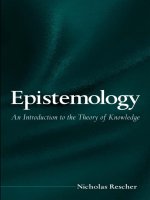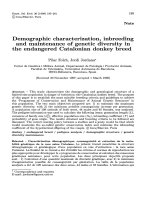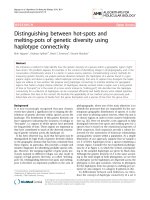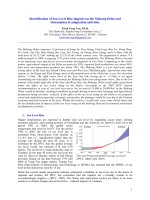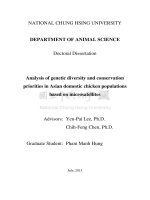Testing on three determining methods of genetic diversity on earthworm species belonging to the Pheretima species group in the Mekong delta
Bạn đang xem bản rút gọn của tài liệu. Xem và tải ngay bản đầy đủ của tài liệu tại đây (436.46 KB, 9 trang )
TẠP CHÍ SINH HỌC, 2012, 34(1): 6-14
TESTING ON THREE DETERMINING METHODS OF GENETIC DIVERSITY
ON EARTHWORM SPECIES BELONGING TO THE PHERETIMA SPECIES
GROUP IN THE MEKONG DELTA
Nguyen Thanh Tung*, Tran Nhan Dung, Pham Minh Tu
Can Tho University, (*)
ABSTRACT: This paper introduced the testing results of three methods (analysis of morphological
characteristics using numerical phenetics, the whole-cell proteins using SDS-PAGE and the DNA
barcode sequences) used for determination of the genetic diversity of some earthworm species belonging
to the Pheretima species group in the Mekong Delta (Amynthas paraalexandri, A. juliani, Metaphire
posthuma, M. bahli, M. peguana, M. houlleti, Metaphire sp.8, Polypheretima elongata and
P. taprobanae). All three methods yielded compatible and reliable results which appropriately explained
the genetic relationships between closely related species and those between taxa of high taxonomic levels
(families, genera). Phylogenetic tree constructed on the basis of DNA barcode analysis was able to
indicate clearly genetic divergence between Pheretima species belonging to acoecata and coecata.
Metaphire sp.8 was demonstrated to be a closely related species with M. houlleti.
Key words: DNA barcode, earthworm, phenetics, Pheretima, SDS-PAGE, Me Kong Delta.
INTRODUCTION
Genetic diversity, the level of biodiversity,
refers to the total number of genetic characteristics
in the genetic makeup of a species. Depending on
different stages of development of the biological
science, determining methods of genetic diversity
has changed and evolved over time. As the
Pheretima species groups contain a large number
of species, species division and classification into
smaller genera are necessary, but the amendment
process for these species was based only on
morphological markers [4, 11, 14, 18]. DNA
barcode (a gene segment of mitochondrial
Cytochrome C Oxidase subunit I) was considered
as a useful molecular marker that might be able to
determine the genetic relationships between
earthworm species [3, 9, 10, 15]. In this study, the
whole-cell protein eletrophoretic analysis using
SDS-PAGE was also tested to examine the
genetic relationships between different species.
This study could provide a basis to improve
the current classification system of the
Pheretima species group in Vietnam and even
possible, in the world.
MATERIALS AND METHODS
Samples
Pairs of closely related earthworm species
Amynthas paraalexandri (Nguyen, 2011),
6
A. juliani (Perrier, 1872), Metaphire posthuma
(Vaillant, 1868), M. bahli (Gates, 1945),
M. peguana (Rosa, 1889), M. houlleti (Perrier,
1872),
Metaphire
sp.8
=
Pheretima
campanulata (Thai, 2000), Polypheretima
elongata (Perrier, 1872) and P. taprobanae
(Beddard, 1892) were collected in many
different localities in the Mekong Delta. Adult
earthworms were stored in 4% formalin solution
for morphological analysis and in 96% ethanol
for DNA extraction while the alive earthworms
were used for extraction of whole-cell proteins.
Scientific name of species used follow the
classification system of Sims and Easton (1972)
[18]. In addition, Pontodrilus litoralis and
Pontoscolex corethrurus were used for
morphological analysis and DNA barcodes of 10
species obtained from the GeneBank were used
for molecular analysis.
Methods
Morphologial analysis with numerical
phenetics: the construction of a phylogenetic tree
with numerical phenetics was based on
morphology as described below: Determining the
important morphological characteristics of
the studied earthworms (table 1) based on
previous studies of Thai Tran Bai (1986),
Easton (1979), Ishizuka (1999), Sims and
Easton (1972) [1, 11, 13, 18]. Identifying the
Nguyen Thanh Tung, Tran Nhan Dung, Pham Minh Tu
important morphological characteristics that are
valuable in the classification of earthworms. For
the highly variable traits, those with the highest
probability of existence among individuals
within species were analyzed, while the
multistate traits were divided into groups. The
common characteristics of selected studied
species were recorded. The traits of all species
were encoded into a binary matrix. Genetic
similarity was measured by Dice’s/Nei and Li’s
coefficients. The similarity matrix was
subjected to cluster analysis by unweighted pair
group method for arithmetic mean (UPGMA).
The dendrogram was generated using the
program NTSYS-PC 2.1 with clustering
algorithms SAHN (Sequential, Agglomerative,
Hierarchical, and Nested clustering methods).
Support for clusters was evaluated by
bootstrapping analysis with 1000 bootstrap
replicates by using FreeTree software.
Table 1. Traits and morphological characteristics that were used to determine the genetic diversity
of earthworm species
No.
Morphological characteristic
Trait
1
Size body
1: small; 2: medium; 3: large
2
The colour of body between ventral and dorsal
4: similar; 5: different
3
Prostomium
6: Epi; 7: Pro
4
The first dorsal pore
8: absent; 9: in 11/12; 10: in 12/13
5
Septa type
11: pericheatin; 12: lumbricin
6
Ratio septa between VIII/XXX
13: >1; 14: <1; 15: = 1
7
Clitellum
16: annular; 17: saddle-shaped
8
Number of clitellum segment
18: 3 segment; 19: 5 segment; 20: segment
9
The first location of clitellum
21: in XIII; 22: in XIV; 23: in XV
10
Spermathecae
24: 1 segment; 25: 2 segment; 26: 3
segment; 27: 4 segment
11
The first location of spermathecae pore
28: in 5/6; 29: in 6/7; 30: in 7/8
12
Number of spermathecae pore in a segment
31: polytheca; 32: bitheca
13
Location of spermathecae pore in a segment
33: ventral; 34: lateral - ventral
14
Number of female pore
35: single; 36: pair
15
Location of male pore
37: in XVIII; 38: in 19/20
16
Types of male pore
39: type 1; 40: type 2; 41: type 3; 42: type 4
17
Genital marking
43: absent; 44: single; 45: pair
18
Types of genital gland
46: absent; 47: type 1; 48: type 2
19
External marking
49: existence; 50: absent
20
Intestinal caeca
51: absent; 52: simple
21
Types of micronephridia
53: meroic; 54: holoic
22
Location of diverticulum
55: near spermathecae pore; 56: origin of
duct of ampulla; 57: in duct of ampulla
23
Number of diverticulum in a spermathecae
58: absent; 59: one
24
Types of prostate glands
60: absent; 61: tubular; 62: racemose
25
Calcium gland
63: absent; 64: existence
26
Situation of septa in 8/9
65: absent; 66: thickness
27
Number of testis sacs
67: 2 pair; 68: 1 pair
28
Location of seminal vesicles
69: in XI and XII; 70: in XIII
Whole-cell protein electrophoretic analysis
using SDS-PAGE: this method included steps as
follows: Extracting proteins: earthworms were
weighed promptly after they had been
desensitized so as to minimize protein
degradation. Five grams of tissues of eachworm
7
TẠP CHÍ SINH HỌC, 2012, 34(1): 6-14
species were homogenized with previously
cooled mortars and pestles in 0.5 ml protein
extraction buffer (0.05 M phosphate buffer, pH 7
+ 0.5% NaCl + EDTA + 1 mM PMSF + 5 mM
EDTA). The contents were centrifuged at 10 rpm
for 10 minutes at 4oC and the supernatants were
stored at 5oC. Measuring protein concentration:
protein concentration was calibrated by Bradford
(1976) method [7]. SDS-PAGE was performed
following the Leammil (1970) protocol [16].
DNA barcode analysis: this method
included steps as follows: Genomic DNA of
earthworms was extracted by following the
CTAB procedure [20] with few modifications.
DNA barcodes were amplified by Polymerase
Chain Reaction using the universal primers
LCO1490 and HCO2198 [12]. This pair of
primers did not work well for A. paraalexandri
and M. houlleti and was thus modified slightly
by using another pair of primers, for which
primer HCO2198 was replaced by primer COIE [8]. PCR products were purified using the
PureLink™ Genomic DNA Mini Kit (Applied
Biosystems, CA, USA) following the protocol
provided by the manufacturer. Sequencing was
performed with the Cycle Sequencing Ready
Reaction Kit, V3.1 (Applied Biosystems, CA,
USA) on an ABI 3130 Genetic Analyzer
following the standard cycle sequencing
protocol. Amplified COI fragments were
checked with the GeneBank BLASTN 2.2.26+
algorithm to verify that all sequences were from
Oligochaeta. The mean interspecific distance as
well as interspecific p-distances were calculated
in MEGA5. Eight previously sequenced DNA
fragments together with 10 additional DNA
barcode sequences from 10 different species of
three distinct earthworm families retrieved from
the GeneBank were used to construct the
common phylogenetic tree. Sequences were
aligned using Clustal X 1.81. Regions that could
not be unambiguously aligned were excluded
from analysis. Alignment was improved
manually using BIOEDIT 5.0.9.
Phylogenetic construction was performed by
applying maximum parsimony (MP) method
using PAUP 4.0b10. MP tree with 1000
bootstrap replicates was analyzed by heuristic
search with tree-bisection-reconnection (TBR)
8
branch-swapping algorithm implemented in the
PAUP program.
RESULTS AND DISCUSSION
Genetic relationships between earthworm
species determined on the basis of
morphological characteristics
The mean interspecific relationship was
26.85% [sd = 10.22], ranging from a low of
7.14% between M. houlleti and Metaphire sp.8 to
a high of 42.86% between P. elongata and
Metaphire sp.8 and between P. taprobanae and
Metaphire sp.8 (table 1).
The dendrogram constructed from the
similarity matrix of 10 taxa showed that 10
species could be grouped into two big groups
(figure 1). Group 1: included Pontoscolex
corethrurus
that
belongs
to
the
Glossoscolecidae family with 100% bootstrap
support. Group 2: included 9 taxa that derived
from the Megascolecidae family with relative
high bootstrap support of 66%. Within the
group 2, the Pheretimoid earthworms (indicated
in bold) formed a monophyletic sub-group with
100% bootstrap support that were apart from the
branch of Pontodrilus litoralis (group 2C).
These earthworms, in turn, can be divided into
two sub-groups denoted 2A and 2B. Sub-group
2A included 4 taxa: P. elongata, P. taprobanae,
M. posthuma and A. paraalexandri while subgroup 2B contained M. bahli, M. peguana,
M. houlleti và Metaphire sp.8. The two subgroups have hight bootstrap and the values of
that were 82% and 83%, respectively.
The dendrogram clearly distinguished the
genetic relationships between taxa of different
families and genera. To be more specific, the
dendrogram appropriately showed that species
of the genus Pheretima in 2A and 2B subgroups had closer relationships than those of
Pontodrilus litoralis that belongs to the genus
Pontodrilus (group 2C). All species of
Megascolecidae (2A, 2B and 2C) showed less
genetic divergence compared with Pontoscolex
corethrurus (group 1) of the Glossoscolecidae
family. Moreover, the topology of this
dendrogram also gave a nice description of
evolutionary divergence between earthworms
Nguyen Thanh Tung, Tran Nhan Dung, Pham Minh Tu
belonging to the Pheretima species group. In
more detail, 6 species of the Pheretimoid
earthworms were divided into three pairs of taxa
in the dendrogram: M. bahli and M. Peguana;
M. houlleti and Metaphire sp.8; P. elongata and
P. taprobanae.
Table 1. Genetic relationship between 8 species based on morphological traits
Species
[1] Metaphire bahli
[2] Metaphire peguana
[3] Metaphire houlleti
[4] Metaphire sp.8
[5] Metaphire posthuma
[6] Amynthas paraalexandri
[7] Polypheretima elongata
[8]Polypheretima taprobanae
[1]
10.71
25.00
28.57
32.14
32.14
32.14
32.14
[2]
[3]
[4]
[5]
[6]
[7]
[8]
14.29
17.86
28.57
25.00
32.14
32.14
7.14
32.14
28.57
35.71
35.71
39.29
35.71
42.86
42.86
25.00
17.86
25.00
28.57
21.43
17.86
-
Interspecific relationship (given in percentage) for 8 earthworm species were calculated by NTSYS-PC 2.1
using Dice’s coefficient.
40
36
2A
82
100
II
72
66
2B
83
92
100
2C
1
I
Figure 1. A dendrogram generated using UPGMA method with arithmetic average analysis
of 10 taxa based on the analysis of morphological traits
The numbers at the nodes indicate the confidence limits for the grouping of those species in a branch based on
1,000 cycles in bootstraps analysis using the FreeTree program. I. Glossoscolecidae; II. Megascolecidae.
The above results were highly consistent
with the current perspectives on morphological
taxonomy but were not without some
inconsistency. According to Sims and Easton
(1972) [18], the Pheretima species group that
had the intestinal caeca were divided into
smaller genera including Metaphire, Amynthas,
Pithema and Pheretima. Nevertheless, the
dendrogram in figure 1 and table 1 showed that
A. paraalexandri had closer relationship with
9
TẠP CHÍ SINH HỌC, 2012, 34(1): 6-14
M. posthuma and M. peguana (genetic distance
were 25%) than with other species belonging
the genus Metaphire (e.g. Genetic distance
between M. posthuma and M. houlleti was
39.29%). Some previous research on molecular
analyses also gave similar results [10].
According to Easton (1979) [11], the Pheretima
species group that was acoecata evolved faster
compared to coecata and diverged in another
evolutionary direction. Nevertheless, the
dendrogram showed that M. posthuma had
closer relationships with P. elongata and
P. taprobanae (did not have the intestinal
caeca) (genetics distances ranged from 17.8% to
25%) than with other species that had the
intestinal caeca (28.57% to 39.29%).
Genetic relationships between earthworm
species determined on the basis of whole-cell
protein electrophoretic analysis using SDSPAGE
116 kDa →
66,2 kDa →
45 kDa →
35kDa →
25kDa →
0
1
2
3
4
5
6
7
8
Figure 2. Electrophoretic patterns of the whole-cell proteins of eight earthworm species belonging
to the Pheretima species group in the Me Kong delta
0. protein ladder; 1. M. houlleti; 2. Metaphire sp.8; 3. M. bahli; 4. M. peguana;
5. P. elongata; 6. P. taprobanea; 7. M. posthuma; 8. A. juliani.
Interspecific p-distances were calculated by
NTSYS-PC 2.1 based on the electrophoretic
pattterus of the whole-cell proteins of 8 species
(figure 2). The mean interspecific distance was
36.66% (SD = 14.53%), which was 8.86%
higher than that calculated based on
morphology (SD = 8.98). These distances
ranged from a high of 92,68% (100% - 7.32%)
between M. posthuma and A. juliani to a low of
38,89% (100% - 61.11%) between M. houlleti
and M. bahli (table 2).
The topology of the phylogenetic tree based
on banding patterns of the whole-cell proteins
showed that investigated earthworms could be
divided in two big groups with the bootstrap
support of 100%. Group 1: consisted of 4
species: M. houlleti, Metaphire sp.8, M. posthuma
and A. juliani, while group 2 contained 4 species:
10
M. bahli, M. peguana, P. elongata and
P. taprobanea. These two groups did not
represent any taxonomic unit. This tree also
clearly exhibited the genetic diversity between
earthworm species in the species group as shown
by relationship between M. houlleti and
Metaphire sp.8 (genetic similarities of 11.11%,
bootstrap support of 85%); M. posthuma and
A. juliani (genetic similarities of 7.32%,
bootstrap support of 93%); M. bahli and
M. peguana (genetic similarities of 10.53%,
bootstrap support of 96%). Both dendrograms
(based on morphological traits and whole-cell
protein patterns) did not show clearly the
division between species groups that did not have
the intestinal caeca (P. elongata, P. taprobanea)
and those that had the intestinal caeca (remaining
species).
Nguyen Thanh Tung, Tran Nhan Dung, Pham Minh Tu
Table 2. Genetic relationship between 8 species based on whole-cell protein electrophoretic analysis
using SDS-PAGE
Species
[1] Metaphire bahli
[2] Metaphire peguana
[3] Metaphire houlleti
[4] Metaphire sp. 8
[5] Metaphire posthuma
[6] Amynthas juliani
[7] Polypheretima elongata
[8] Polypheretima taprobanae
[1]
10.53
61.11
52.63
58.97
50.00
31.58
39.54
[2]
[3]
[4]
[5]
[6]
[7]
50.00
42.11
48.72
40.00
26.32
34.88
11.11
18.92
21.05
44.44
51.22
23.08
25.00
36.84
53.49
7.32
38.46
36.36
40.00
33.33
39.54
[8]
-
Notes: Interspecific p-distances (given in percentage) for 8 earthworm species were calculated by NTSYS-PC
2.1 using Dice’s coefficient.
1
2
Figure 3. A dendrogram generated using UPGMA method with arithmetic average analysis of 8
taxa based on the analysis of proteins banding patterns
The numbers at the nodes indicate the confidence limits for the grouping of those species in a branch based on
1,000 cycles in bootstraps analysis using the FreeTree program.
Genetic relationships between earthworm
species determined on the basis of DNA
barcodes analysis
The
mean
interspecific
relationship
calculated based on the data of DNA barcodes
was 16.99% ranging from a low of 14.32%
between P. elongata and P. taprobanae to a
high of 19.79% between M. bahli and
A. paraalexandri (table 3). This was 10.81%
and 19.67% lower than that previously
calculated mean of interspecific relationship
based on the similarity matrix of morphology
and protein banding patterns, respectively.
Genetic relationship between species calculated
based on DNA barcodes data (sd = 1.32) were
less variable than those calculated using the data
morphological
(10.22)
and
protein
electrophoretic analyses (14.53).
In this study, result based on morphological
and protein electrophoretic analyses showed that
Metaphire sp.8 and M. houlleti had low genetic
similarities (7.14% and 11.11%, respectively).
By contrast, this value increased to 15.68%,
being higher than the genetic similarities between
two closely related species M. peguana and
M. bahli (14.61%) and between two species that
did not have the intestinal caeca (14.32%). This
demonstrated that Metaphire sp.8 is a probably
new species that has a close relationship with
M. houlleti.
11
TẠP CHÍ SINH HỌC, 2012, 34(1): 6-14
Table 3. Genetic relationship between 8 species based on DNA barcodes anaylysis
Species
[1] Metaphire bahli
[2] Metaphire peguana
[3] Metaphire houlleti
[4] Metaphire sp.8
[5] Metaphire posthuma
[6] Amynthas paraalexandri
[7] Polypheretima elongata
[8] Polypheretima taprobanae
[1]
14.61
17.35
17.66
18.42
19.79
15.07
17.96
[2]
[3]
[4]
[5]
[6]
[7]
[8]
17.35
16.89
15.22
18.42
15.83
17.96
15.68
16.89
18.87
16.13
17.20
17.50
16.89
16.44
17.96
17.66
15.83
16.13
18.11
17.50
14.32
-
Interspecific relationship (given in percentage) for the 8 species were calculated in MEGA5.
In studies previously published in Vietnam,
Metaphire sp.8 were identified as Pheretima
campanulata [2] but Rosa (the author published
this species) suggested that it was the synonym
of M. houlleti [5].
The topology of the cladogram showed
three distinct clades with variable bootstrap
support (figure 4). Clade 1 had only one
Pontoscolex corethrurus species with 68%
bootstrap support and this is reasonable as this
species belongs to the other earthworm family
(Glossoscolecidae). This agreed with the
dendrogram construction based on morphology
and current perspectives on the classification of
earthworms. Clade 2 was the largest and most
apical clade that consisted of all 15 taxa of the
Megascolecidae family with relatively high
bootstrap support of 50%. Clade 3 consisted of
two species of Eisenia fetida and Lumbricus
terrestris of the Lumbricidae family with high
bootstrap support of 83%.
Figure 4. Maximum parsimony analysis of a 639 bp fragment of the COI gene after combination of
partial COI sequences from the GeneBank
Numbers at nodes indicated bootstrap values from 1000 replicates. I. Glossoscolecidae; II. Megascolecidae;
III. Lumbricidae.
Within clade II, Pontodrilus litoralis was
separated from the other species with the bootstrap
support of 50%. This is similar with many
12
previous research of taxonomic position for this
species. The genus Pontodrilus was categorized as
a member of the Acanthodrilidae, however the
Nguyen Thanh Tung, Tran Nhan Dung, Pham Minh Tu
data on molecular biology that have been
published recently showed that Pontodrilus
litoralis had a closer relationship with other
species of Megascolecidae than those of
Acanthodrilidae [6]. Although Perionyx excavatus
belongs to a distinct genus but it has not been
separated from Pheretima species group yet.
In addition, the maximum parsimony tree
based on DNA barcodes data clearly exhibited
the evolutionary divergence between the
Pheretimoid earthworms that are coecata
(Amynthas and Metaphire species) and acoecata
(P. elongata and P. taprobanae), when the later
group evolved earlier and separated from the
others on the cladogram with the bootstrap
support of 70%. This pattern was not
recognized in the dendrograms constructed
based
on
morphological and protein
eletrophoretic analysis. Besides, the species of
the genus Amynthas including A. hawayanus,
A. triastriatus và A. robustus formed a
monophyletic group with the bootstrap support
of 67% except A. paraalexandri which was
outside this group. This is similar with other
studies when the clear distinction of species
division of Amynthas and Metaphire was not
observed all the time [15].
CONCLUSIONS
species of Amynthas and Metaphire into two
groups, while the tree based on DNA barcode
analysis showed the trend of separation but not
very clear in all species.
Metaphire sp.8 is a closely related species
with M. houlleti.
REFERENCES
1. Thái Trần Bái, 1986. Khóa định loại các
loài giun đất ở đồng bằng sông Hồng và
đồng bằng sông Cửu Long Việt Nam. Đại
học Sư phạm Hà Nội: 3-20.
2. Thái Trần Bái, 2000. Đa dạng loài giun đất
ở Việt Nam. Những vấn đề nghiên cứu cơ
bản trong sinh học. Đại học quốc gia Hà
Nội: 307-311.
3. Trần Thị Thanh Bình, Đặng Tất Thế, 2006.
Dẫn liệu DNA của hai loài giun đất
Pheretima aspergillum và Pheretima
robusta. Tạp chí Khoa học, đại học Sư
phạm Hà Nội, 4: 130-135.
4. Apuan D. A., Anthony M., Torres J. and
Demayo C. G., 2010. Describing variations
and taxonomic status of earthworms
collected from selected areas in Misamis
Oriental, Philippines using principal
component and parsimony analysis. Egypt.
Acad. J. Biol. Sci., 2(1): 27-36.
All of three methods: morphological, the
whole-cell protein electrophoretic and DNA
barcode analyses yielded compatible and reliable
results which appropriately explained the genetic
relationships between closely related species in
the Pheretima species group.
Phylogenetic trees constructed on the basis
of morphological and DNA barcode analysis
clearly exhibited genetic relationships at
different taxonomic levels (families and genera)
(except Perionyx excavatus).
Relationships between the species of the
Pheretimoid earthworms that have and do not
have the intestinal caeca were exclusively
shown on the phylogenetic tree constructed
based on DNA barcodes analysis.
5. Beddard F. E., 1895. A Monograph of the
Order of Oligochaeta. Oxford, Clarendon
Press: 424-426.
Phylogenetic trees constructed based on
morphological and protein electrophoretic
analyses did not show the differentiation of the
9. Chang C. H. and Chen J. H., 2005.
Taxonomic status and intraspecific
phylogeography of two sibling species of
6. Blakemore R. J., 2007. Origin and means
of dispersal of cosmopolitan Pontodrilus
litoralis (Oligochaeta: Megascolecidae).
Eur. J. Soil. Biol., 43: S3-S8.
7. Bradford M. M., 1976. A rapid and
sensitive for the quantitation of microgram
quantitites of protein utilizing the principle
of protein-dye binding. Anal. Biochem., 72:
248-254.
8. Bely A. E. and Wray G. A., 2004. Molecular
phylogeny of naidid worms (Annelida;
Clitellata) based on cytochrome c oxidase I.
Mol. Phylogenet Evol., 30: 50-63.
13
TẠP CHÍ SINH HỌC, 2012, 34(1): 6-14
Metaphire (Oligochaeta: Megascolecidae)
in Taiwan. Pedobiol., 49: 591-600.
10. Chang C. H., Lin S. M. and Chen J. H.,
2008.
Molecular
systematics
and
phylogeography of the gigantic earthworms
of the Pheretima formosae species group
(Clitellata,
Megascolecidae).
Mol.
Phylogenet Evol., 49(3): 958-968.
11. Easton E. G., 1979. A revision of the
'acaecate' earthworms of the Pheretima
group (Megascolecidae: Oligochaeta):
Archipheretima,
Metapheretima,
Planapheretima,
Pleionogaster
and
Polypheretima. Bull. Br. Mus. Nat. Hist.
(Zool.), 35: 1-126.
12. Folmer O., Black M., Hoeh W., Lutz R.
and Vrijenhoek R., 1994. DNA primers for
amplification of mitochondrial cytochrome
c oxidase subunit I from diverse metazoan
invertebrates. Mol. Mar. Biol. Biotechnol,
3: 294-299.
13. Ishizuka K., 1999. A review of the genus
Pheretimas. lat. (Megascolecidae) from
Japan Edaphol., 62: 55-80.
14. Jamieson B. G. M., 1988. On the
phylogeny and higher classification of the
Oligochaeta. Cladistics, 4: 367-410.
15. Huang J., Xu Q., Sun Z. J., Tang G. L. and
Su Z. Y., 2007. Identifying earthworms
through DNA barcodes. Pedobiol., 51(4):
301-309.
16. Laemmli U. K., 1970. Cleavage of
structural proteins during the assembly of
the head of bacteriophage T4. Nature,
227(5259): 680-685.
17. Rogers S. O. and Bendich A. J. B., 1988.
Extraction of DNA from plant tissues. Plant
molecular Biology Manual. Klurwer
Academic Publishers, Dordrecht, Belgium:
1-10.
18. Sims R. W. and Easton E. G., 1972. A
numerical revision of the earthworm genus
Pheretima
auct.
(Megascolecidae:
Oligochaeta) with the recognition of new
genera and an appendix on the earthworms
collected by the Royal Society North
Borneo Expedition. Biol. J. Lin. Soc., 4:
169-268.
THỬ NGHIỆM 3 PHƯƠNG PHÁP XÁC ĐỊNH MỐI QUAN HỆ ĐA DẠNG
DI TRUYỀN TRÊN MỘT SỐ LOÀI GIUN ĐẤT THUỘC NHÓM LOÀI
PHERETIMA Ở ĐỒNG BẰNG SÔNG CỬU LONG
Nguyễn Thanh Tùng, Trần Nhân Dũng, Phạm Minh Tú
Trường đại học Cần Thơ
TÓM TẮT
Bài báo này giới thiệu kết quả thử nghiệm 3 phương pháp (phân tích dựa trên cơ sở hình thái học, điện di
protein SDS - PAGE, giải trình tự mã vạch DNA Barcode) để xác định mối quan hệ đa dạng di truyền ở một số
loài giun đất thuộc nhóm Pheretima ở đồng bằng sông Cửu Long (Amynthas paraalexandri, A. juliani,
Metaphire posthuma, M. bahli, M. peguana, M. houlleti, Metaphire sp.8, P. elongata và P. taprobanae). Cả 3
phương pháp đều cho kết quả tương thích, chính xác để giải thích mối quan hệ giữa các loài trong nhóm loài
gần gũi và giữa tác taxon bậc cao (họ, giống). Mối quan hệ giữa 2 nhóm Pheretima không có manh tràng và
có manh tràng chỉ được thể hiện rõ khi xây dựng sơ đồ phả hệ dựa trên trình tự DNA Barcode. Mối quan hệ
giữa các loài trong giống Amynthas và Metaphire chưa thể hiện rõ ở phương pháp hiện trạng số và điện di
protein SDS-PAGE, có xu hướng rõ hơn khi so sánh trình tự DNA barcode. Từ kết quả nghiên cứu cũng đã
chứng minh được Metaphire sp.8 là 1 loài gần gũi với M. houlleti.
Từ khóa: Pheretima, đa dạng di truyền, giun đất, hình thái học, mã vạch DNA, SDS-PAGE đồng bằng
sông Cửu Long.
Ngày nhận bài: 30-8-2010
14
